View in other NatureServe Network Field Guides
NatureServe
Montana
Utah
Wyoming
Idaho
Wisconsin
British Columbia
South Carolina
Yukon
California
New York
Western Harvest Mouse - Reithrodontomys megalotis
Native Species
Global Rank:
G5
State Rank:
S5
(see State Rank Reason below)
Agency Status
USFWS:
USFS:
BLM:
External Links
State Rank Reason (see State Rank above)
Species is apparently secure and not at risk of extirpation or facing significant threats in all or most of its range.
General Description
The relatively small Western Harvest Mouse averages 5 1/2 inches long and less than 1/2 ounce in weight. Its scaly tail comprises more than half of its length. The upper fur and tail color appears grayish brown, with a darker midline and buffy sides. Below, tail and body are white or grayish. Along with the nearly hairless bicolored tail, large ears and a groove running down the front of each incisor help differentiate the Western Harvest Mouse from similar mammals.
Diagnostic Characteristics
See Hoofer et al. (1999) for information on discrimination between R. megalotis and R. montanus using cranial characters.
Species Range
Montana Range
Range Descriptions
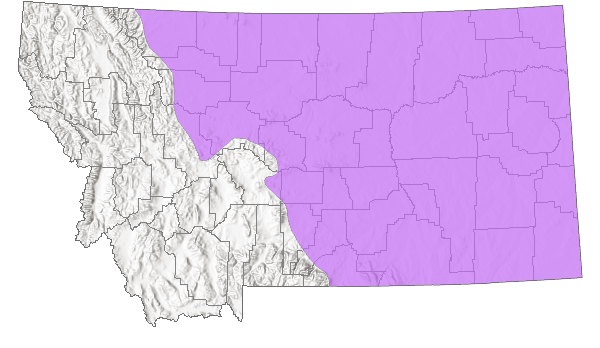
 Native
Native
Global Range

Estimated global breeding range area is: 5,391,077 km
2 (Approximately 5% in Montana)
See information about
 iNaturalist Geomodels
iNaturalist Geomodels
Observations in Montana Natural Heritage Program Database
Number of Observations: 252
(Click on the following maps and charts to see full sized version)
Map Help and Descriptions
Relative Density
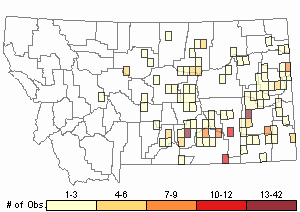
Recency
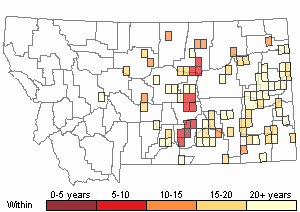
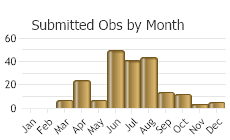
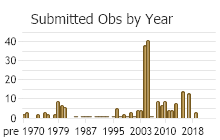
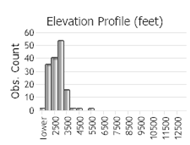 (Observations spanning multiple months or years are excluded from time charts)
(Observations spanning multiple months or years are excluded from time charts)
Migration
Non-migratory.
Habitat
Dense grassy areas, sage-grassland.
National Vegetation Classification System Groups Associated with this Species
Forest and Woodland
Low Elevation - Xeric Forest and Woodland
Shrubland
Arid - Saline Shrubland
Sagebrush Shrubland
Grassland
Lowland - Prairie Grassland
Sparse and Barren
Sparse and Barren
Wetland and Riparian
Alkaline - Saline Wetlands
Peatland
Riparian and Wetland Forest
Riparian Shrubland
Wet Meadow and Marsh
Recently Disturbed or Modified
Introduced Vegetation
Human Land Use
Agriculture
Developed
Food Habits
Granivorous, also consumes some herbaceous materials and insects.
Ecology
Tolerant of conspecifics.
Reproductive Characteristics
Average 4.0 young/litter (n=2). In warmer parts of range breeds year round. Probably March to October in MT. Females are sexually mature in 4 months, polyestrous, several litters year.
Stewardship Responsibility
References
- Literature Cited AboveLegend:
 View Online Publication
View Online Publication Hoofer, S.R., J.R. Choate, and N.E. Mandrak. 1999. Mensural discrimination between Reithrodontomys megalotis and R. montanus using cranial characters. Journal of Mammalogy 80:91-101.
Hoofer, S.R., J.R. Choate, and N.E. Mandrak. 1999. Mensural discrimination between Reithrodontomys megalotis and R. montanus using cranial characters. Journal of Mammalogy 80:91-101.
- Additional ReferencesLegend:
 View Online Publication
View Online Publication
Do you know of a citation we're missing? Allen, K.L., T. Weaver, and D. Flath. 1994. Small mammals in Northern Rocky Mountain ecosystems. Unpubl. report to Bureau of Land Management and United States Forest Service, August 31, 1994. Montana State Univ., Bozeman. 54 pp.
Allen, K.L., T. Weaver, and D. Flath. 1994. Small mammals in Northern Rocky Mountain ecosystems. Unpubl. report to Bureau of Land Management and United States Forest Service, August 31, 1994. Montana State Univ., Bozeman. 54 pp. Bachen, D.A. 2014. Cheatgrass invasion of sagebrush steppe: Impacts of vegetation structure on small mammals. M.Sc. Thesis. Bozeman, Montana: Montana State University. 96 p.
Bachen, D.A. 2014. Cheatgrass invasion of sagebrush steppe: Impacts of vegetation structure on small mammals. M.Sc. Thesis. Bozeman, Montana: Montana State University. 96 p. Bauer, Delane, 2002, 2002 Four Seasons Wildlife Study. Savage Mine Report, Richland County, Montana.
Bauer, Delane, 2002, 2002 Four Seasons Wildlife Study. Savage Mine Report, Richland County, Montana. Bowdoin NWR. 2000. A survey of the small, terrestrial mammals at Bowdoin NWR: Malta, Montana.
Bowdoin NWR. 2000. A survey of the small, terrestrial mammals at Bowdoin NWR: Malta, Montana. Bramblett, R.G., and A.V. Zale. 2002. Montana Prairie Riparian Native Species Report. Montana Cooperative Fishery Research Unit, Montana State University - Bozeman.
Bramblett, R.G., and A.V. Zale. 2002. Montana Prairie Riparian Native Species Report. Montana Cooperative Fishery Research Unit, Montana State University - Bozeman. Clark, B. K. and D. W. Kaufman. 1990. Short-term responses of small mammals to experimental fire in tallgrass prairie. Can. J. Zool. 68:2450-2454.
Clark, B. K. and D. W. Kaufman. 1990. Short-term responses of small mammals to experimental fire in tallgrass prairie. Can. J. Zool. 68:2450-2454. Clark, B. K., et al. 1988. Long-distance movements by Reithrodontomys megalotis [sic] in tallgrass prairie. Am. Midl. Nat. 120:276-281
Clark, B. K., et al. 1988. Long-distance movements by Reithrodontomys megalotis [sic] in tallgrass prairie. Am. Midl. Nat. 120:276-281 Clark, S.G. and M.R. Stromberg. 1987. Mammals in Wyoming. University of Kansas Museum of Natural History, Public Education Series Number 10. xii + 314 pp.
Clark, S.G. and M.R. Stromberg. 1987. Mammals in Wyoming. University of Kansas Museum of Natural History, Public Education Series Number 10. xii + 314 pp. Dames & Moore. 1975. Interim report environmental baseline studies for Crow Indian coal leases: known as Tract II and Tract III, Westmoreland Resources, Sarpy Creek Basin, Big Horn County, Montana. Billings, Mont.
Dames & Moore. 1975. Interim report environmental baseline studies for Crow Indian coal leases: known as Tract II and Tract III, Westmoreland Resources, Sarpy Creek Basin, Big Horn County, Montana. Billings, Mont. Dood, A.R. 1980. Terry Badlands nongame survey and inventory final report. Montana Department of Fish, Wildlife, and Parks and Bureau of Land Management, Helena, MT. 70 pp.
Dood, A.R. 1980. Terry Badlands nongame survey and inventory final report. Montana Department of Fish, Wildlife, and Parks and Bureau of Land Management, Helena, MT. 70 pp. ECON, Inc. (Ecological Consulting Service), Helena, MT., 1975, Colstrip 10 x 20 Area wildlife and wildlife habitat annual monitoring report, 1975. Proj. 71-23-A. December 31, 1975.
ECON, Inc. (Ecological Consulting Service), Helena, MT., 1975, Colstrip 10 x 20 Area wildlife and wildlife habitat annual monitoring report, 1975. Proj. 71-23-A. December 31, 1975. ECON, Inc. (Ecological Consulting Service), Helena, MT., 1979, Annual wildllife report of the Colstrip Area for 1978. Proj. 195-85-A. April 6, 1979.
ECON, Inc. (Ecological Consulting Service), Helena, MT., 1979, Annual wildllife report of the Colstrip Area for 1978. Proj. 195-85-A. April 6, 1979. Econ, Inc. 1988. Wildlife monitoring report, 1987 field season, Big Sky Mine. March 1988. In Peabody Mining and Reclamation Plan Big Sky Mine Area B. Vol. 8, cont., Tab 10 - Wildlife Resources. Appendix 10-1, 1987 Annual Wildlife Report.
Econ, Inc. 1988. Wildlife monitoring report, 1987 field season, Big Sky Mine. March 1988. In Peabody Mining and Reclamation Plan Big Sky Mine Area B. Vol. 8, cont., Tab 10 - Wildlife Resources. Appendix 10-1, 1987 Annual Wildlife Report. Econ, Inc., Helena, MT., 1978, Peabody Coal Company Big Sky Mine, Rosebud County, MT. Wildlife and wildlife habitat monitoring study. Proj. 190-85-A. December 31, 1978.
Econ, Inc., Helena, MT., 1978, Peabody Coal Company Big Sky Mine, Rosebud County, MT. Wildlife and wildlife habitat monitoring study. Proj. 190-85-A. December 31, 1978. Fjell, Alan K., 1986, Peabody Coal Company Big Sky Mine, Rosebud County, MT. Wildlife monitoring report: 1985 field season. March 1986.
Fjell, Alan K., 1986, Peabody Coal Company Big Sky Mine, Rosebud County, MT. Wildlife monitoring report: 1985 field season. March 1986. Fjell, Alan K., and Brian R. Mahan, compilers., 1984, Peabody Coal Company Big Sky Mine, Rosebud County, MT. Wildlife monitoring report: 1983 field season. February 1984.
Fjell, Alan K., and Brian R. Mahan, compilers., 1984, Peabody Coal Company Big Sky Mine, Rosebud County, MT. Wildlife monitoring report: 1983 field season. February 1984. Fjell, Alan K., and Brian R. Mahan., 1985, Peabody Coal Company Big Sky Mine, Rosebud County, MT. Wildlife monitoring report: 1984 field season. February 1985.
Fjell, Alan K., and Brian R. Mahan., 1985, Peabody Coal Company Big Sky Mine, Rosebud County, MT. Wildlife monitoring report: 1984 field season. February 1985. Fjell, Alan K., and Brian R. Mahan., 1987, Big Sky Mine, Rosebud County, MT. Wildlife monitoring report: 1986 field season. April 1987.
Fjell, Alan K., and Brian R. Mahan., 1987, Big Sky Mine, Rosebud County, MT. Wildlife monitoring report: 1986 field season. April 1987. Foresman, K.R. 2001. The wild mammals of Montana. American Society of Mammalogists, Special Publication Number 12. Lawrence, KS. 278 pp.
Foresman, K.R. 2001. The wild mammals of Montana. American Society of Mammalogists, Special Publication Number 12. Lawrence, KS. 278 pp. Foresman, K.R. 2012. Mammals of Montana. Second edition. Mountain Press Publishing, Missoula, Montana. 429 pp.
Foresman, K.R. 2012. Mammals of Montana. Second edition. Mountain Press Publishing, Missoula, Montana. 429 pp. Geppert, T. J. 1984. Small mammals of the Shield Trap, East Pryor Mountain, Montana. M.S. thesis. University of Iowa, Iowa City. 45 pp.
Geppert, T. J. 1984. Small mammals of the Shield Trap, East Pryor Mountain, Montana. M.S. thesis. University of Iowa, Iowa City. 45 pp. Gniadek, S. 1983. Southwest Glendive Wildlife Baseline Inventory. Miles City, Mont: Bureau of Land Management, Miles City District Office. 56 pp with appendices.
Gniadek, S. 1983. Southwest Glendive Wildlife Baseline Inventory. Miles City, Mont: Bureau of Land Management, Miles City District Office. 56 pp with appendices. Hanauska-Brown, L., B.A. Maxell, A. Petersen, and S. Story. 2014. Diversity Monitoring in Montana 2008-2010 Final Report. Montana Fish, Wildlife & Parks. Helena, MT. 78 pp.
Hanauska-Brown, L., B.A. Maxell, A. Petersen, and S. Story. 2014. Diversity Monitoring in Montana 2008-2010 Final Report. Montana Fish, Wildlife & Parks. Helena, MT. 78 pp. Hendricks, P., S. Lenard, D.M. Stagliano, and B.A. Maxell. 2013. Baseline nongame wildlife surveys on the Fort Peck Indian Reservation. Report to the Assiniboine and Sioux Tribes of the Fort Peck Indian Reservation. Montana Natural Heritage Program, Helena, MT. 83 p.
Hendricks, P., S. Lenard, D.M. Stagliano, and B.A. Maxell. 2013. Baseline nongame wildlife surveys on the Fort Peck Indian Reservation. Report to the Assiniboine and Sioux Tribes of the Fort Peck Indian Reservation. Montana Natural Heritage Program, Helena, MT. 83 p. Heske, E. J., R. S. Ostfeld and W. Z. Lidicker, Jr. 1984. Competitive interactions between Microtus californicus and Reithrodontomys megalotis during two peaks of Microtus abundance. J. Mammal. 65:271-280.
Heske, E. J., R. S. Ostfeld and W. Z. Lidicker, Jr. 1984. Competitive interactions between Microtus californicus and Reithrodontomys megalotis during two peaks of Microtus abundance. J. Mammal. 65:271-280. Hoffmann, R.S. and D.L. Pattie. 1968. A guide to Montana mammals: identification, habitat, distribution, and abundance. Missoula, MT: University of Montana. 133 p.
Hoffmann, R.S. and D.L. Pattie. 1968. A guide to Montana mammals: identification, habitat, distribution, and abundance. Missoula, MT: University of Montana. 133 p. Hoffmann, R.S., P.L. Wright, and F.E. Newby. 1969. The distribution of some mammals in Montana. I. Mammals other than bats. Journal of Mammalogy 50(3): 579-604.
Hoffmann, R.S., P.L. Wright, and F.E. Newby. 1969. The distribution of some mammals in Montana. I. Mammals other than bats. Journal of Mammalogy 50(3): 579-604. Holmes, Brian. 2003. Ecology and Persistence of Sylvatic Plague in Phillips County, Montana. MS Thesis. University of Montana, Missoula, MT.
Holmes, Brian. 2003. Ecology and Persistence of Sylvatic Plague in Phillips County, Montana. MS Thesis. University of Montana, Missoula, MT. Jones, J.K., D.M. Armstrong, R.S. Hoffmann and C. Jones. 1983. Mammals of the northern Great Plains. University of Nebraska Press, Lincoln. 379 pp.
Jones, J.K., D.M. Armstrong, R.S. Hoffmann and C. Jones. 1983. Mammals of the northern Great Plains. University of Nebraska Press, Lincoln. 379 pp. Joslin, Gayle, and Heidi B. Youmans. 1999. Effects of recreation on Rocky Mountain wildlife: a review for Montana. [Montana]: Montana Chapter of the Wildlife Society.
Joslin, Gayle, and Heidi B. Youmans. 1999. Effects of recreation on Rocky Mountain wildlife: a review for Montana. [Montana]: Montana Chapter of the Wildlife Society. Kaufman, G.A., D.W. Kaufman and E.J. Finck. 1988. Influence of fire and topography on habitat selection by Peromyscus maniculatus and Reithrodontomys megalotis in ungrazed tallgrass prairie. Journal of Mammalogy 69:342-352.
Kaufman, G.A., D.W. Kaufman and E.J. Finck. 1988. Influence of fire and topography on habitat selection by Peromyscus maniculatus and Reithrodontomys megalotis in ungrazed tallgrass prairie. Journal of Mammalogy 69:342-352. Kritzman, E.B. 1977. Little mammals of the Pacific Northwest. Pacific Search Press, Seattle, WA.
Kritzman, E.B. 1977. Little mammals of the Pacific Northwest. Pacific Search Press, Seattle, WA. LaVelle, Darlene. 1988. 1988 Nongame surveys in Region 5 and Region 7.' MTFWP. 40pp.
LaVelle, Darlene. 1988. 1988 Nongame surveys in Region 5 and Region 7.' MTFWP. 40pp. Martin, P.R., K. Dubois and H.B. Youmans. 1981. Terrestrial wildlife inventory in selected coal areas, Powder River resources area final report. Montana Department of Fish, Wildlife and Parks and Bureau of Land Management, Helena, MT. No. YA-553-CTO- 24. 288 p.
Martin, P.R., K. Dubois and H.B. Youmans. 1981. Terrestrial wildlife inventory in selected coal areas, Powder River resources area final report. Montana Department of Fish, Wildlife and Parks and Bureau of Land Management, Helena, MT. No. YA-553-CTO- 24. 288 p. Matthews, W.L. 1980a. Wibaux-Beach comparison study: Sydney, Glendive and Plevna Study Areas. Bureau of Land Management, Miles City, MT. 50 p.
Matthews, W.L. 1980a. Wibaux-Beach comparison study: Sydney, Glendive and Plevna Study Areas. Bureau of Land Management, Miles City, MT. 50 p. Matthews, W.L. 1981. Broadus-Pumpkin Creek baseline inventory - wildlife. Bureau of Land Management, Miles City, MT. 83 p.
Matthews, W.L. 1981. Broadus-Pumpkin Creek baseline inventory - wildlife. Bureau of Land Management, Miles City, MT. 83 p. Montana Dept. of State Lands, 1976, Draft environmental impact statement for proposed open cut mining contract for Amercan Colloid Company. November 12, 1976.
Montana Dept. of State Lands, 1976, Draft environmental impact statement for proposed open cut mining contract for Amercan Colloid Company. November 12, 1976. Pefaur, J. E., and R. S. Hoffmann. 1975. Studies of small mammal populations at three sites on the Northern Great Plains. Occasional Papers of the Museum of Natural History, University of Kansas, Lawrence. No. 37:1-27.
Pefaur, J. E., and R. S. Hoffmann. 1975. Studies of small mammal populations at three sites on the Northern Great Plains. Occasional Papers of the Museum of Natural History, University of Kansas, Lawrence. No. 37:1-27. Pefaur, J.E. and R.S. Hoffmann. 1971. Merriam's shrew and hispid pocket mouse in Montana. American Midland Naturalist 86(1):247-248.
Pefaur, J.E. and R.S. Hoffmann. 1971. Merriam's shrew and hispid pocket mouse in Montana. American Midland Naturalist 86(1):247-248. Powder River Eagle Studies, Inc., Gillette, WY., 1994?, Big Sky Mine 1993 wildlife studies. Date???
Powder River Eagle Studies, Inc., Gillette, WY., 1994?, Big Sky Mine 1993 wildlife studies. Date??? Reid, F. 2006. Peterson Field Guide to Mammals of North America, 4th Edition. Houghton Mifflin Company: Boston and New York, 608 pp.
Reid, F. 2006. Peterson Field Guide to Mammals of North America, 4th Edition. Houghton Mifflin Company: Boston and New York, 608 pp. Schladweiler, Philip, and John P. Weigand., 1983, Relationships of endrin and other chlorinated hydrocarbon compounds to wildlife in Montana, 1981-1982. September 1983.
Schladweiler, Philip, and John P. Weigand., 1983, Relationships of endrin and other chlorinated hydrocarbon compounds to wildlife in Montana, 1981-1982. September 1983. Scow, K.L. 1981. Ecological distribution of small mammals at Sarpy Creek, Montana, with special consideration of the Deer Mouse, Peromyscus maniculatus. M.Sc. Thesis. Bozeman, Montana: Montana State University. 73 p.
Scow, K.L. 1981. Ecological distribution of small mammals at Sarpy Creek, Montana, with special consideration of the Deer Mouse, Peromyscus maniculatus. M.Sc. Thesis. Bozeman, Montana: Montana State University. 73 p. Thompson, L.S. 1981. Circle West wildlife monitoring study: Third annual report. Technical report No. 8. Montana Department of Natural Resources and Conservation. Helena, Montana.
Thompson, L.S. 1981. Circle West wildlife monitoring study: Third annual report. Technical report No. 8. Montana Department of Natural Resources and Conservation. Helena, Montana. Waage, B.C. 1984. Western Energy Company Rosebud Mine, Rosebud County, Montana: Annual Wildlife Monitoring Report, 1983 Field Season. June 1984.
Waage, B.C. 1984. Western Energy Company Rosebud Mine, Rosebud County, Montana: Annual Wildlife Monitoring Report, 1983 Field Season. June 1984. Waage, B.C. 1986. Western Energy Company Rosebud Mine, Rosebud County, Montana: Annual Wildlife Monitoring Report, 1985 Field Season. December 1985.
Waage, B.C. 1986. Western Energy Company Rosebud Mine, Rosebud County, Montana: Annual Wildlife Monitoring Report, 1985 Field Season. December 1985. Waage, Bruce C., 1993, Western Energy Company Rosebud Mine, Colstrip, Montana: Annual Wildlife Monitoring Report; 1992 Field Season. December 1993.
Waage, Bruce C., 1993, Western Energy Company Rosebud Mine, Colstrip, Montana: Annual Wildlife Monitoring Report; 1992 Field Season. December 1993. Waage, Bruce C., 1995, Western Energy Company Rosebud Mine, Colstrip, Montana:1994 Annual Wildlife Monitoring Report; December 1, 1993 - November 30, 1994. February 27, 1995.
Waage, Bruce C., 1995, Western Energy Company Rosebud Mine, Colstrip, Montana:1994 Annual Wildlife Monitoring Report; December 1, 1993 - November 30, 1994. February 27, 1995. Waage, Bruce C., 1996, Western Energy Company Rosebud Mine, Colstrip, Montana: 1995 Annual Wildlife Monitoring Report; December 1, 1994 - November 30, 1995. February 28, 1996.
Waage, Bruce C., 1996, Western Energy Company Rosebud Mine, Colstrip, Montana: 1995 Annual Wildlife Monitoring Report; December 1, 1994 - November 30, 1995. February 28, 1996. Waage, Bruce C., 1999, Western Energy Company Rosebud Mine, Colstrip, Montana: 1998 Annual Wildlife Monitoring Report; December 1, 1997 - November 30, 1998 Survey Period. February 24, 1999.
Waage, Bruce C., 1999, Western Energy Company Rosebud Mine, Colstrip, Montana: 1998 Annual Wildlife Monitoring Report; December 1, 1997 - November 30, 1998 Survey Period. February 24, 1999. Webster, W.D. and J.K. Jones. 1982. Reithrodontomys megalotis. Mamm. Species No. 167. 5 pp.
Webster, W.D. and J.K. Jones. 1982. Reithrodontomys megalotis. Mamm. Species No. 167. 5 pp. Western Energy Co., Colstrip, MT. Unpub., 1983, Western Energy Company's Application for Amendment to Surface Mining Permit NO. 8003, Area B: sections 7, 8, 17,18 T1N R41E, sections 12, 13 T1N R40E, Mining Expansion. March 1983.
Western Energy Co., Colstrip, MT. Unpub., 1983, Western Energy Company's Application for Amendment to Surface Mining Permit NO. 8003, Area B: sections 7, 8, 17,18 T1N R41E, sections 12, 13 T1N R40E, Mining Expansion. March 1983. Western Energy Co., Colstrip, MT., 1980, Western Energy Company Rosebud Mine, Colstrip, Montana: Annual Wildlife Report, 1980.
Western Energy Co., Colstrip, MT., 1980, Western Energy Company Rosebud Mine, Colstrip, Montana: Annual Wildlife Report, 1980. Western Energy Co., Colstrip, MT., 1981, Western Energy Company Rosebud Mine, Colstrip, Montana: Annual Wildlife Report, 1981.
Western Energy Co., Colstrip, MT., 1981, Western Energy Company Rosebud Mine, Colstrip, Montana: Annual Wildlife Report, 1981. Western Energy Co., Colstrip, MT., 1981, Western Energy Company's Application for a Surface Mining Permit: Area C - Block 1. Vol. 1. May 1981.
Western Energy Co., Colstrip, MT., 1981, Western Energy Company's Application for a Surface Mining Permit: Area C - Block 1. Vol. 1. May 1981. Western Technology and Engineering, Inc. (WESTECH)., 1996, Wildlife Monitoring Absaloka Mine Area Annual Report, 1995. Montana SMP 85005. OSMP Montana 0007D. Febr. 23, 1996.
Western Technology and Engineering, Inc. (WESTECH)., 1996, Wildlife Monitoring Absaloka Mine Area Annual Report, 1995. Montana SMP 85005. OSMP Montana 0007D. Febr. 23, 1996. Western Technology and Engineering, Inc. (WESTECH)., 1997, Wildlife Monitoring Absaloka Mine Area Annual Report, 1996. Montana SMP 85005. OSMP Montana 0007D. Mar. 1997.
Western Technology and Engineering, Inc. (WESTECH)., 1997, Wildlife Monitoring Absaloka Mine Area Annual Report, 1996. Montana SMP 85005. OSMP Montana 0007D. Mar. 1997. Western Technology and Engineering, Inc. (WESTECH)., 1999, Wildlife Monitoring Absaloka Mine Area Annual Report, 1998. SMP 85005. OSMP Montana 0007E. April 1999.
Western Technology and Engineering, Inc. (WESTECH)., 1999, Wildlife Monitoring Absaloka Mine Area Annual Report, 1998. SMP 85005. OSMP Montana 0007E. April 1999. Westmoreland Resources, Inc., Hardin, MT., 1981, Upper Sarpy Basin Wildlife Study. In 1981 Wildlife Report. April 1982.
Westmoreland Resources, Inc., Hardin, MT., 1981, Upper Sarpy Basin Wildlife Study. In 1981 Wildlife Report. April 1982.
- Web Search Engines for Articles on "Western Harvest Mouse"
- Additional Sources of Information Related to "Mammals"





